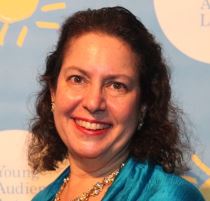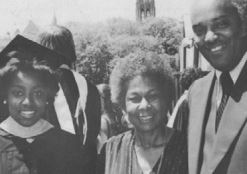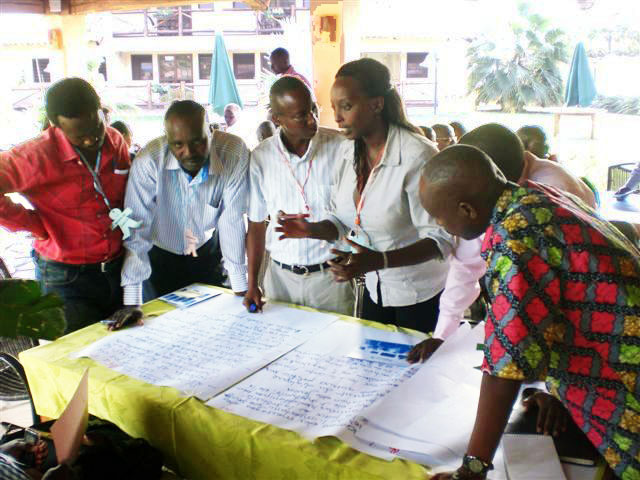Fulfilling the Promise of the American Dream
All college students have dreams for their higher education experience, and what follows. For one group of students, known as Dreamers, the barriers to fulfilling their dreams are particularly high. They are the 1.8 million undocumented children brought to the United States as children and infants. Dreamers who were able to apply for and get DACA (Deferred Action for Childhood Arrivals), which was enacted in 2012, are able—at least for now—to remain in the United States and work legally. But they do not have a path to citizenship. For the almost 100,000 Dreamers graduating from high school each year, they are no longer able to apply for DACA. And, regardless of whether these students have DACA or not, none of them are permitted access to federal aid and they have only limited access to state aid or scholarships to help pay for a college education.
TheDream.US was born in 2013 during a drive to a college campus by Don Graham, then CEO of The Washington Post Company, and his friend Henry Muñoz, then finance chief of the Democratic National Committee. Graham expressed his distress that undocumented students he had met through the DC College Access Program, an organization he had founded, were not able to pursue a college education. For more than 15 years, DC College Access Program had provided pre-enrollment college counseling and modest scholarship resources to low-income Washington, DC public school students. But undocumented students had no access to public funding resources, and, consequently, their college dreams were deferred, if not denied entirely.
 One such “Dreamer” was Gaby Pacheco, who had organized a march from Miami, Florida to Washington, DC to bring attention to the plight of Dreamers. Graham and Muñoz reached out to Gaby, and other friends, including author and journalist Amanda Bennett and former Secretary of Commerce Carlos Gutierrez. They were determined to do something to help Dreamers, and that help would be in the form of scholarship funds. They knew Dreamers were highly-motivated and wanted nothing more than to get a college education, but were unable to do so because they could not access a single dollar of federal aid, had limited access to state or private scholarship aid, and often faced paying out-of-state tuition. This emerging effort that became TheDream.US was anticipated to be a temporary, stopgap measure—almost a form of disaster aid for Dreamers—until Congress could enact legislation that would provide access to federal aid and a path to citizenship. Five years later, Congress has not yet acted and TheDream.US has made college possible for thousands of Dreamers, while their status as American citizens remains uncertain.
One such “Dreamer” was Gaby Pacheco, who had organized a march from Miami, Florida to Washington, DC to bring attention to the plight of Dreamers. Graham and Muñoz reached out to Gaby, and other friends, including author and journalist Amanda Bennett and former Secretary of Commerce Carlos Gutierrez. They were determined to do something to help Dreamers, and that help would be in the form of scholarship funds. They knew Dreamers were highly-motivated and wanted nothing more than to get a college education, but were unable to do so because they could not access a single dollar of federal aid, had limited access to state or private scholarship aid, and often faced paying out-of-state tuition. This emerging effort that became TheDream.US was anticipated to be a temporary, stopgap measure—almost a form of disaster aid for Dreamers—until Congress could enact legislation that would provide access to federal aid and a path to citizenship. Five years later, Congress has not yet acted and TheDream.US has made college possible for thousands of Dreamers, while their status as American citizens remains uncertain.
Building Alternative Supports
If the conventional vehicles supporting low-income students to access and complete college were not going to be available to Dreamers, then an alternative set of supports would need to be put in place. Resources were quickly mobilized during the first year of TheDream.US. Don Graham and his partners recruited Candy Marshall, an experienced philanthropy leader, along with Gaby Pacheco to help build the necessary program infrastructure. They decided that since TheDream.US was likely to be a short-term venture, and the student needs were immediate, they would design a small, flexible, virtual organization to guide its work. With distributed decision-making among an ensemble of just three and later six professionals, they were able to act at great speed and build momentum for the initiative. Their back-office scholarship program management needs were handled at first by Scholarship America, and later the International Scholarship & Tuition Services.
In response to Graham’s passionate pleas to funders of scholarships and wealthy sympathizers of Dreamers, TheDream.US was able to raise more than $33 million in its first year of operation. Founding funders were wealthy and concerned individuals giving through foundations, including the Graham family, The Bill & Melinda Gates Foundation, The Chan Zuckerberg Initiative, and Pershing Square Foundation; corporate funders, such as The Coca-Cola Foundation and The PepsiCo Foundation; and other individuals and anonymous donors.
At the same time, TheDream.US was developing a set of twelve partnerships with higher education institutions in California, Florida, New York, Texas, and Washington, D.C. to provide a four-year degree to these students at a cost of $25,000 or less, all-inclusive of tuition and fees. Scholarship candidates had to show evidence of high school completion and their DACA or TPS (Temporary Protected Status) status, and meet other eligibility requirements as specified in the application guidelines. Less than a year later, more than 300 Dreamers were enrolled as TheDream.US Scholars, and this initial student cohort then grew annually.
To date, over 5,000 scholarships have been awarded to TheDream.US Scholars, representing a commitment of more than $140 million in funds. With this private support, these Dream.US Scholars are now pursuing their higher education dreams at 70+ partner colleges in 16 states and Washington, D.C. In addition to meeting degree cost thresholds, these partner colleges have demonstrated excellence at supporting low-income, first-generation students, and ensuring their degree completion. To accommodate those Dreamers who live in “locked-out states” where they have no access to in-state tuition or, in some cases, in-state institutions, TheDream.US has also created a complementary Opportunity Scholarship Award of up to $80,000 for a bachelor’s degree at partner institutions.
Scholars Find Hope
TheDream.US Scholars include such students as Maria TrevinoRodriguez, who is attending the University of Houston while working full-time. She has said that “TheDream.US not only financially supported my aspiration to pursue a higher education when my family was struggling to make ends meet, but also serves as a support network that consistently works to bridge the gaps that allow bright, undocumented students to fall through the cracks in our educational system.” Another unnamed Scholar, who is now beginning a career as a computer scientist/software engineer, said that “The week before my graduation when I found out that I had passed all my classes, I got home and as soon as I saw my parents, we all just embraced and cried together. This wouldn’t be true without this scholarship. It’s more than money for tuition; it’s opportunity, hope, encouragement, belief, bravery, and love.”
Marshall believes other funders should also open up scholarship programs to undocumented students. She noted that their exclusion was often simply an administrative oversight; standard scholarship program language sometimes requests evidence of U.S. citizenship without fully understanding the consequences of imposing that specific requirement.
Results to Date
TheDream.US results to date have been remarkable, despite the daily challenges confronting these undocumented students and their families. Driven to succeed and contribute, TheDream.US Scholars have outperformed their low-income peers in college persistence and completion. According to TheDream.US 2018 Progress Report, TheDream.US Scholars (100 percent of which are low-income and 80 percent of which are first generation) have an average 93 percent first-year persistence rate. This compares to a national rate of 74 percent for all U.S. college students (regardless of income or college generation). The Program also produced outsized results for overall persistence with 88 percent of its over 4,000 Scholars still enrolled in comparison to a 76 percent rate for all U.S. college students.
The selection of affordable and welcoming higher education partners, known for promoting social mobility, has been critical to generating this level of student success. The current roster of 70 plus partner institutions have shown a clear commitment to meeting both the academic and non-academic needs of undocumented students, including guidance on employment, healthcare, immigration resources, and nutrition. About 80 percent of the partners are four-year institutions, and 20 percent are two-year institutions. The largest presence is within the City University of New York (CUNY) system, where 18 institutions and 800 Scholars are involved.
Each Scholar is provided a “trusted navigator for college and life,” according to Marshall, and a cohort with a minimum of 7–10 Scholars is formed at each institution each year. In many instances, the institutions have gone well beyond designating holistic advisors for these Scholars, and some have established full-fledged Dreamer Resource Centers. Each partner institution has a six-person team: program relationship manager, scholar advisor, financial aid advisor, admissions counselor, mental health counselor, and media contact.
Marshall also noted that partner institutional leaders, such as Patricia McGuire, president of Trinity Washington University, have described how TheDream.US Scholars have changed the culture of campuses. Their presence has made other students “more aware of social justice concerns,” despite the daily challenges associated with their undocumented status. In a commentary for The Chronicle of Higher Education, McGuire wrote that “…our Dreamers must live each day stressed about the uncertainty in their lives, worried about losing the work permits and drivers’ licenses that are essential to support their families, and fearful that ICE will show up at their doors anyway despite all of our promises to protect them.” She went on to cite what a Dreamer had written in her college application: “By enduring this journey I learned that the worst thing I could have done was give up.”
In the fall of 2018, TheDream.US issued In Their Own Words, a report summarizing the findings from a survey of 1,400 of its Scholars. The report also included policy and practice recommendations to help further the success of these DACA and TPS students. The report’s findings included the following:
- 97 percent of the Scholars indicated that obtaining a college degree was extremely or very important to them.
- 66 percent plan to pursue a career that requires professional licensing, including medical, legal, and engineering careers, even though professional licenses are often not available to non-citizens.
- 71 percent were employed, and 29 percent worked full-time. • Over one-third provided some form of financial support to their families.
- 43 percent experienced food insecurity in the past year.
- 83 percent were “very anxious” about their immigration status, and 86 percent were concerned about the legal status of their family.
Online communications facilitate interaction among TheDream.US Scholars. A national virtual community enables the Scholars to support each other across campuses; the students offer practical advice to each other on such matters as study habits. In addition, an active and growing network of TheDream.US Alumni is also providing opportunities for career advancement and community service.
Dreamers Changing Reality
 According to Marshall, TheDream.US founder Don Graham had long been a believer in the life-changing power of scholarships and considered them one of the best uses of philanthropic resources. Creating TheDream.US was a natural extension of his lifelong efforts to improve opportunities for others and increase college access and completion resources. But what he and others expected to be a temporary stop-gap scholarship solution for a discrete group of low-income college students has now grown into a national movement to provide greater certainty for Dreamers and their families.
According to Marshall, TheDream.US founder Don Graham had long been a believer in the life-changing power of scholarships and considered them one of the best uses of philanthropic resources. Creating TheDream.US was a natural extension of his lifelong efforts to improve opportunities for others and increase college access and completion resources. But what he and others expected to be a temporary stop-gap scholarship solution for a discrete group of low-income college students has now grown into a national movement to provide greater certainty for Dreamers and their families.
TheDream.US, its many individual and institutional partners, and the Scholars themselves are becoming a vibrant and vocal force in advocating for legal status for undocumented students, including a path to citizenship. Public opinion, as tracked in major media polls, confirms overwhelming support for Dreamers to be able to remain in the U.S. and pursue their educational and career dreams. The Scholars have also brought their own credible voices to statehouses, where they urge lawmakers to provide access to both in-state tuition rates and institutions.
As summed up by McGuire in her Chronicle opinion piece, “We cannot give up on the chance for a much better future for our Dreamers. By enrolling these remarkable students, we embrace the challenge to accompany them on this journey as far as we must go.” Yet TheDream.US is the rare scholarship program that hopes its legacy will be its own demise—that its mission will be fulfilled and deemed no longer necessary. Until that time comes, TheDream.US will continue supporting its current and future Scholars— regardless of whether DACA is rescinded. Meanwhile, the program’s Alumni Network of graduates continues to grow; as Marshall said with confidence, “When we go away, they will have each other and a college education— and no one can take that away from them.” Working together, TheDream. US Scholars and their dedicated supporters are determined to make this dream come true.
For more on TheDream.US visit thedream.us.
This case study is one of 12 in a suite of case studies focused on how donors are supporting scholarships to create change. The case studies have been developed in companionship with Candid’s project Scholarships for Change, a dynamic hub that pulls together data and knowledge to tell the story of how philanthropic dollars are supporting transformative scholarships.





